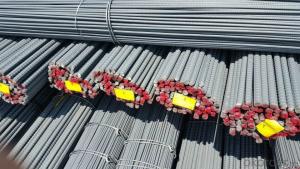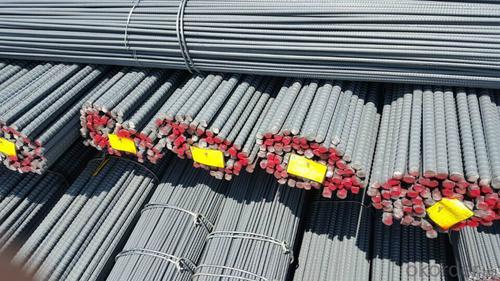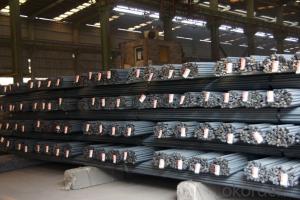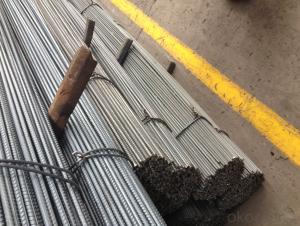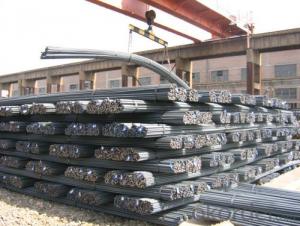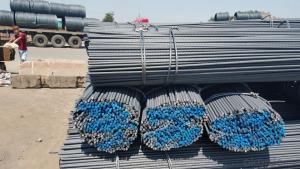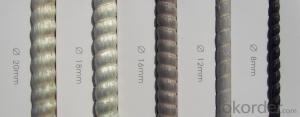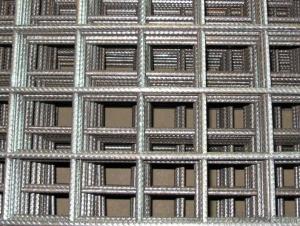Reinforcing Deformed Steel Bars in Grade HRB400 with Best Quality
- Loading Port:
- Tianjin
- Payment Terms:
- TT OR LC
- Min Order Qty:
- 25 m.t.
- Supply Capability:
- 20000 m.t./month
OKorder Service Pledge
OKorder Financial Service
You Might Also Like
Specification
OKorder is offering high quality Hot Rolled Rebars at great prices with worldwide shipping. Our supplier is a world-class manufacturer of steel, with our products utilized the world over. OKorder annually supplies products to Africa, North American and Asian markets. We provide quotations within 24 hours of receiving an inquiry and guarantee competitive prices.
Product Applications:
Deformed bar is widely used in buildings, bridges, roads and other engineering construction. Big to highways, railways, bridges, culverts, tunnels, public facilities such as flood control, dam, small to housing construction, beam, column, wall and the foundation of the plate, deformed bar is an integral structure material. With the development of world economy and the vigorous development of infrastructure construction, real estate, the demand for deformed bar will be larger and larger.
Product Advantages:
OKorder's Hot Rolled Rebars are durable, strong, and resist corrosion.
Main Product Features:
· Premium quality
· Prompt delivery & seaworthy packing (30 days after receiving deposit)
· Corrosion resistance
· Can be recycled and reused
· Mill test certification
· Professional Service
· Competitive pricing
Product Specifications:
Manufacture: Hot rolled
Grade: HRB400 – HRB500
Certificates: ISO, SGS, BV, CIQ
Length: 6m – 12m, as per customer request
Packaging: Export packing, nude packing, bundled
Grade | Technical data of the original chemical composition (%) | ||||||
C | Mn | Si | S | P | V | ||
HRB400 | ≤0.25 | ≤1.60 | ≤0.80 | ≤0.045 | ≤0.045 | 0.04-0.12 | |
Physical capability | |||||||
Yield Strength (N/cm²) | Tensile Strength (N/cm²) | Elongation (%) | |||||
≥400 | ≥570 | ≥14 | |||||
Theoretical weight and section area of each diameter as below for your information:
Diameter(mm) | Section area (mm²) | Mass(kg/m) | Weight of 12m bar(kg) |
6 | 28.27 | 0.222 | 2.664 |
8 | 50.27 | 0.395 | 4.74 |
10 | 78.54 | 0.617 | 7.404 |
12 | 113.1 | 0.888 | 10.656 |
14 | 153.9 | 1.21 | 14.52 |
16 | 201.1 | 1.58 | 18.96 |
18 | 254.5 | 2.00 | 24 |
20 | 314.2 | 2.47 | 29.64 |
22 | 380.1 | 2.98 | 35.76 |
25 | 490.9 | 3.85 | 46.2 |
28 | 615.8 | 4.83 | 57.96 |
32 | 804.2 | 6.31 | 75.72 |
36 | 1018 | 7.99 | 98.88 |
40 | 1257 | 9.87 | 118.44 |
50 | 1964 | 15.42 | 185.04 |
FAQ:
Q1: Why buy Materials & Equipment from OKorder.com?
A1: All products offered by OKorder.com are carefully selected from China's most reliable manufacturing enterprises. Through its ISO certifications, OKorder.com adheres to the highest standards and a commitment to supply chain safety and customer satisfaction.
Q2: How do we guarantee the quality of our products?
A2: We have established an advanced quality management system which conducts strict quality tests at every step, from raw materials to the final product. At the same time, we provide extensive follow-up service assurances as required.
Q3: How soon we can delivery the goods ?
A3: We have a mill with 20000mts of capacity per month. We can delivery the goods within in one month ,as long as your order quantity less than 20000mts
Q4:What's your payment terms ?
A4:Mostly,we collect the money by T/T and LC at sight . We also accept time LC at 90/120 days sight.
Images
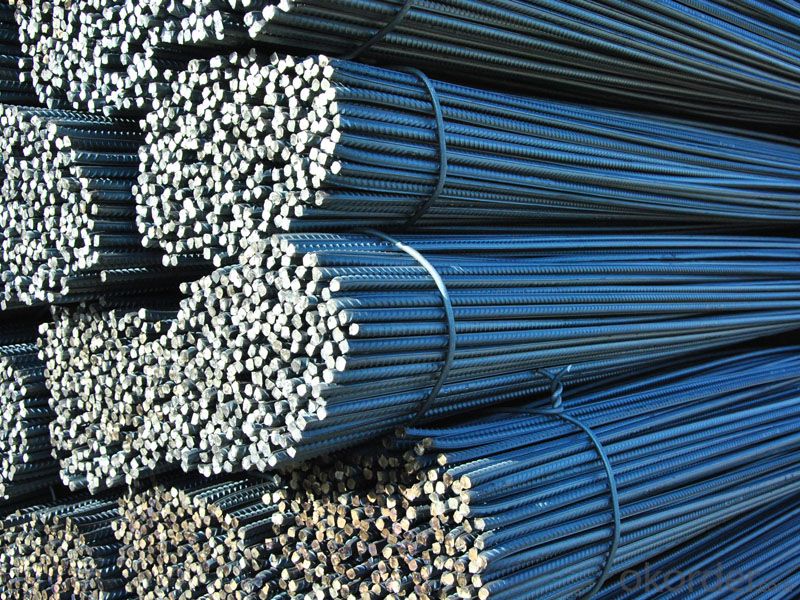
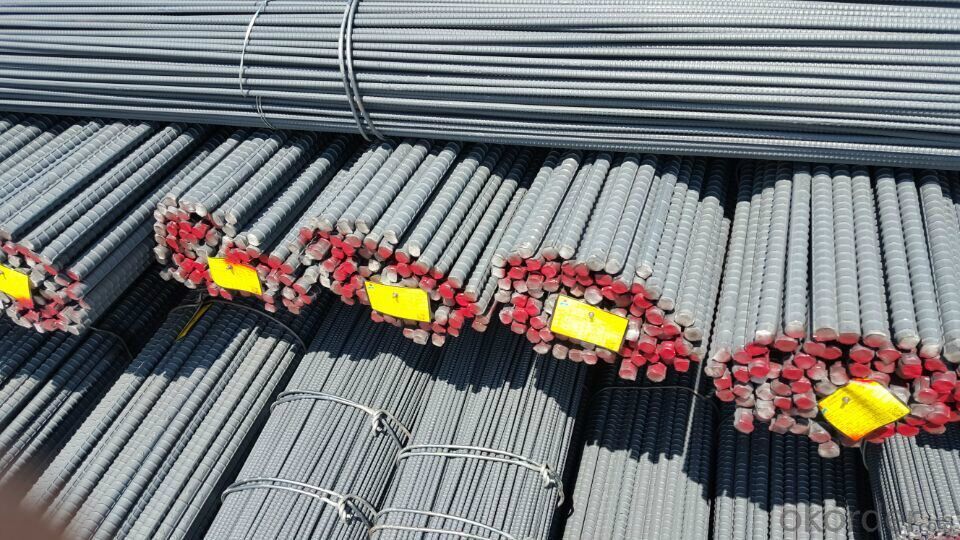
- Q: What is the effect of steel rebars on the thermal conductivity of concrete?
- The effect of steel rebars on the thermal conductivity of concrete is generally negligible. While steel has a higher thermal conductivity than concrete, the relatively low volume fraction of rebars in typical reinforced concrete structures does not significantly impact the overall thermal conductivity of the material.
- Q: What is the role of steel rebars in preventing structural vibrations?
- Steel rebars play a crucial role in preventing structural vibrations by providing reinforcement and stability to concrete structures. The rebars, which are embedded within the concrete, enhance the overall strength and rigidity of the structure, making it more resistant to vibrations caused by external factors such as wind, earthquakes, or heavy machinery. The presence of steel rebars helps to distribute and dissipate the energy generated during vibrations, reducing their amplitude and preventing potential structural damage or collapse.
- Q: How do steel rebars improve the structural integrity of a building?
- Steel rebars improve the structural integrity of a building by reinforcing concrete structures, providing additional strength and stability. The rebars act as a skeleton within the concrete, distributing and transferring loads more effectively, preventing cracks and reducing the risk of collapse.
- Q: Can steel rebars be used in wastewater treatment plants?
- Yes, steel rebars can be used in wastewater treatment plants. Steel rebars are commonly used as reinforcement for concrete structures, including those found in wastewater treatment plants. The rebars provide strength and durability to the structures, ensuring they can withstand the harsh environments and corrosive nature of wastewater. However, it is important to select the appropriate grade of steel rebars that are resistant to corrosion caused by the chemicals present in wastewater.
- Q: How do steel rebars impact the constructability and formwork requirements of concrete elements?
- The constructability and formwork requirements of concrete elements are greatly affected by steel rebars. These reinforcement bars, also called rebars, are extensively used in concrete construction to strengthen and increase the durability of structural elements. To begin with, the presence of rebars impacts the constructability of concrete elements by providing structural integrity and load-bearing capacity. By strategically placing rebars in areas like beams, columns, and slabs, the overall strength and stability of the structure are significantly improved. This enables the construction of larger and more intricate concrete elements, as rebars help distribute loads more efficiently. Additionally, rebars also have an impact on the formwork requirements of concrete elements. Formwork refers to the temporary structure used to support the concrete until it sets and gains enough strength to support itself. The inclusion of rebars requires careful consideration when designing the formwork, as the presence of reinforcement bars can increase the weight and volume of the concrete. The size, spacing, and positioning of rebars influence the design and construction process of the formwork. The formwork must be designed to accommodate the rebars and ensure proper placement and consolidation of the concrete around them. This may entail additional reinforcement in the formwork, such as tie wires or supports, to prevent displacement or movement of the rebars during concrete pouring. Furthermore, rebars also impact the overall timeline and cost of the construction project. The need for additional formwork materials and reinforcement can raise both material and labor costs. Additionally, the presence of rebars may require more time for formwork installation, concrete pouring, and curing, as the rebars need to be correctly positioned and secured within the concrete elements. In conclusion, steel rebars have a significant impact on the constructability and formwork requirements of concrete elements. They enhance the structural integrity of the concrete, allowing for the construction of larger and more intricate elements. However, their inclusion also necessitates careful planning and design of the formwork, considering the size, spacing, and positioning of the rebars. Overall, rebars play a crucial role in ensuring the strength, stability, and longevity of concrete structures.
- Q: What is the difference between hot-rolled and cold-rolled steel rebars?
- The main difference between hot-rolled and cold-rolled steel rebars lies in the manufacturing process. Hot-rolled steel rebars are created by heating the steel billets and passing them through rollers to shape them into the desired form. This process results in a rougher surface and a larger diameter tolerance. On the other hand, cold-rolled steel rebars are manufactured by cooling the steel billets and then passing them through rollers at room temperature. This process produces a smoother surface and a more precise diameter tolerance. Overall, the choice between hot-rolled and cold-rolled steel rebars depends on the specific requirements of the application.
- Q: What are the properties of steel rebars?
- Steel rebars, also known as steel reinforcing bars, possess several important properties. Firstly, they have high tensile strength, making them capable of withstanding heavy loads and stresses without breaking or bending easily. Secondly, they have excellent durability and resistance to corrosion, which ensures their long-term structural integrity. Moreover, steel rebars exhibit good thermal conductivity, allowing them to dissipate heat efficiently in high-temperature environments. Additionally, they are malleable and can be easily bent or shaped to fit different construction needs. Lastly, steel rebars have excellent bond strength with concrete, enabling the efficient transfer of loads between the two materials in reinforced concrete structures.
- Q: What is the average lifespan of steel rebars in concrete structures?
- The average lifespan of steel rebars in concrete structures can vary depending on several factors. Generally, if the concrete is of good quality and properly maintained, the rebars can last for several decades. However, exposure to environmental conditions such as moisture, chemicals, and temperature fluctuations can accelerate the corrosion process, leading to a shorter lifespan. In areas with high humidity or proximity to saltwater, rebars may corrode more quickly. Additionally, poor construction practices, such as inadequate concrete cover or improper placement of rebars, can also impact their lifespan. Regular maintenance and inspections can help identify any potential issues and extend the lifespan of steel rebars in concrete structures.
- Q: How do steel rebars contribute to the overall stiffness of a structure?
- Steel rebars contribute to the overall stiffness of a structure by providing reinforcement to the concrete. The rebars are embedded within the concrete, allowing them to resist tension forces that would otherwise cause the concrete to crack or fail. This reinforcement helps to distribute and resist loads more effectively, increasing the overall stiffness and strength of the structure.
- Q: Are steel rebars resistant to chemical attacks?
- The resistance of steel rebars to chemical attacks may vary depending on the specific chemicals they encounter, although they are typically resistant. Steel rebars are primarily composed of carbon steel, renowned for its exceptional strength and durability. Carbon steel exhibits good resistance to numerous common chemicals, including water, mild acids, and alkalis. Nevertheless, certain chemicals can pose a threat to steel rebars by inducing corrosion or deterioration. For instance, powerful acids like sulfuric acid or hydrochloric acid can swiftly corrode steel rebars. Furthermore, exposure to chlorides, such as those present in saltwater or deicing salts, can heighten the risk of corrosion in steel rebars. To bolster the resistance of steel rebars against chemical attacks, several protective measures can be implemented. One prevalent approach involves the application of protective coatings, such as epoxy or zinc, onto the rebars. These coatings create a barrier between the steel and the chemicals, preventing direct contact and reducing the likelihood of corrosion. In conclusion, although steel rebars generally exhibit resistance to chemical attacks, their resistance can be influenced by the specific chemicals they encounter. By implementing appropriate protective measures, their resistance can be enhanced, thus prolonging their lifespan in environments where chemical exposure is a concern.
Send your message to us
Reinforcing Deformed Steel Bars in Grade HRB400 with Best Quality
- Loading Port:
- Tianjin
- Payment Terms:
- TT OR LC
- Min Order Qty:
- 25 m.t.
- Supply Capability:
- 20000 m.t./month
OKorder Service Pledge
OKorder Financial Service
Similar products
Hot products
Hot Searches
Related keywords
